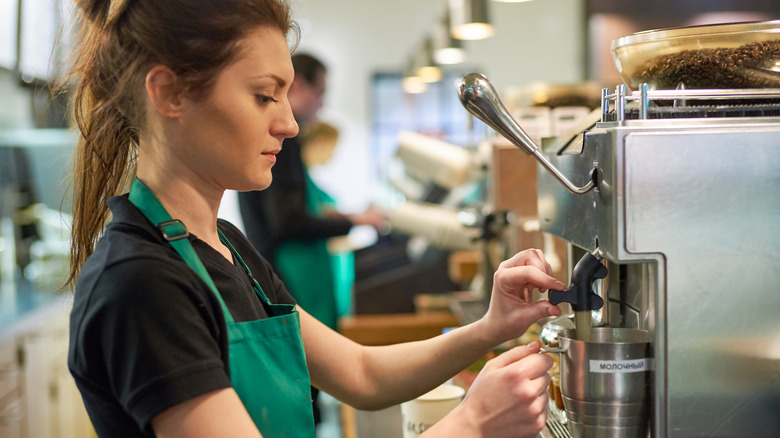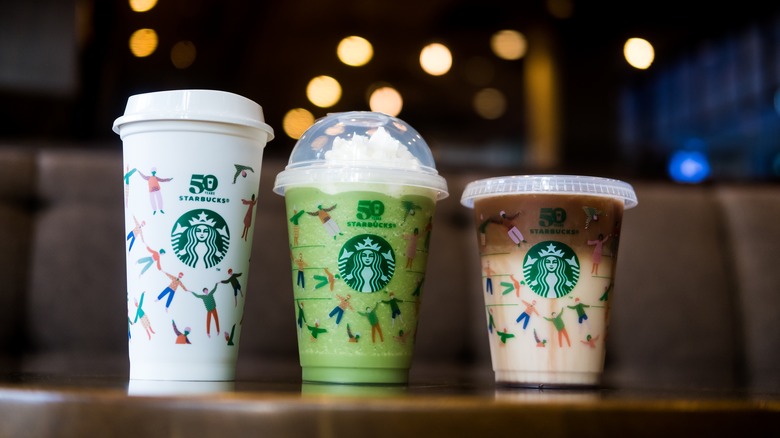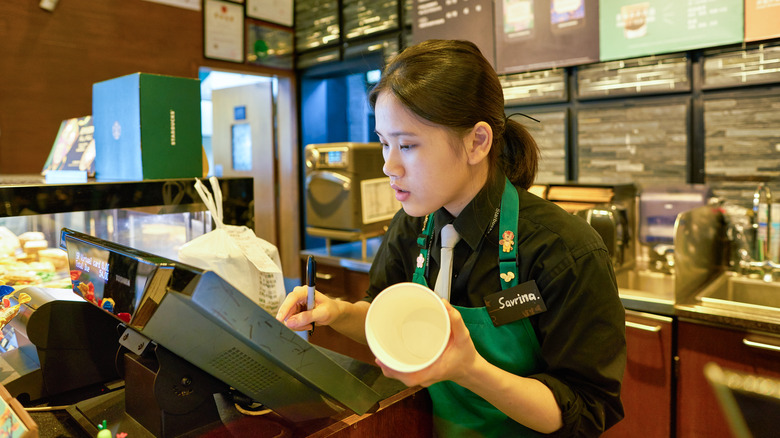Do Starbucks Baristas Need To Memorize All Of The Drink Recipes?
Out of a wide array of choices for coffee, from local hole-in-the-walls to some of the best coffee chains around the world, Starbucks is one place caffeine seekers tend to gravitate toward without fail. For many customers, it's simply a convenient option, with the prominent chain boasting over 32,000 locations in 80 countries, per the Starbucks website. For others, it could also be Starbucks' sprawling drink selection. From the chain's signature frosted Frappuccinos to traditional cold brews and Americanos, there's something for any type of caffeine consumer.
With the wide availability of beverages on Starbucks menus expanding and changing every year (and often every holiday), the draw for customers continues to grow. But for the people running the whole operation, it could be a whole different story. The menu additions just don't stop, and that means employees have a whole lot to learn. The Starbucks brand just added a nitro-brewed coffee in 2016, per CNBC, and a blonde espresso option sprang up two years later, according to Fortune – not to mention, there always seems to be a seasonal special. As the coffee giant continues to grow on all sides with each passing year, are Starbucks baristas really expected to memorize all of the drinks?
Just how big is the Starbucks menu, anyway?
When you arrive at a Starbucks cafe, most of them will only have a small sliver of the actual menu on display. While the signs in stores might show just a selected offering of what could be had, there is a huge number of drink combinations available at any given Starbucks. According to The Telegraph, the possibilities hover somewhere around 87,000 (although most baristas won't be familiar with many of those "secret menu" items you find on the internet unless you describe them yourself). And that doesn't even include the chain's food.
Many of the "official" menu upgrades come from more recent years. The chain started out very humbly back in 1971, with only the most basic coffee and espresso offerings. According to Starbucks, the company initially wanted to stay as true as possible to the feel of traditional Italian espresso bars, so it wouldn't even so much as offer nonfat milk. (Whole milk is the trade standard.) Obviously, over time, that mentality changed, and even almond milk had its debut at Starbucks in 2016.
But the chain opened itself up to much more than new milks over the course of its evolution, especially in the 2010s. Per the Starbucks website (and the memory of any fan of the chain's sweet cream cold brew), cold brew coffee wasn't available at the chain until 2015. As time goes on, the menu keeps growing, and in turn, the challenge for employees grows as well.
How much of the menu do Starbucks baristas have to learn?
As one experienced barista shared with Insider, yes, baristas memorize Starbucks' extensive beverage list. While it may seem like a lot to learn initially, most of the drinks are based on only a few simple formulas, so trained baristas should be well-equipped to make almost any drink or variation with ease. Newbies are also shown the basics such as working the register before learning the espresso bar, so they have time to acclimate themselves before being thrown into the deep end.
But how exactly do they learn it all? One other former Starbucks clerk shared her experiences with training on Quora and said most stores utilize a few methods to make it happen. Usually, trainers will start by giving newbies the lowdown on the most basic drinks using flashcards before working their way up to more complex beverages. So, with the downtime spent working the register, new baristas should have plenty of time to study the cards.
While this method works for some, other baristas have even made their own cheat sheets to help speed up the learning process, like Reddit user u/macchiat-no. No matter the method, the information gets absorbed somehow. And for that, we thank the bearers of our favorite caffeinated beverages for putting in the time to learn all of our favorites.


